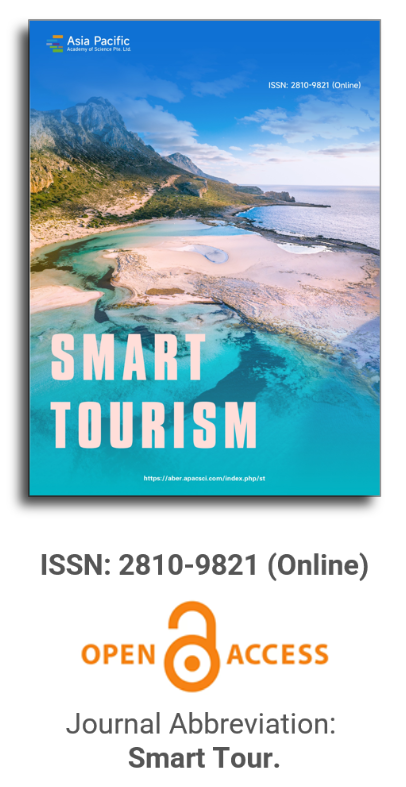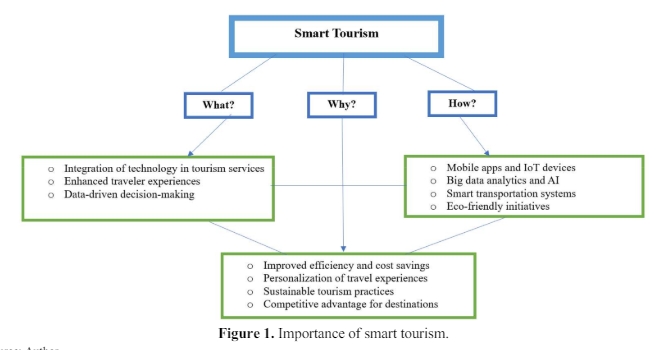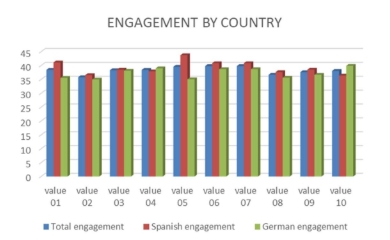


Promoting sustainable development has been a significant goal of the tourist industry, given various challenges it faces today. This issue focuses on ways to increase the sustainability and competitiveness of tourist destinations using innovation and technology. These studies not only offer us a thorough grasp of the current state of the tourism business but also suggest the way forward for the future growth of the industry.
Full Issue
| View or download the full issue |
Issue release: 30 December 2024
This paper evaluates the Smart Tourism Destination indicators and Standards for Sustainable and Smart Cities applied in Tourist Resorts in São Paulo State, Brazil, through the “DTI-BR Model”. This model selects the most suitable indicators for the Brazilian context, drawing on sources like SEGITTUR (the Spanish State-owned Company for the Management of Innovation and Tourism Technologies) and the Brazilian Technical Standards for Smart Cities. The study emphasizes the importance of using indicators to assess and standardize the evaluation of municipal tourism departments, highlighting their role in optimizing tourist resources, and underscores the necessity for tourist destinations to comprehend and integrate these indicators fully to improve service quality, environmental management, and the overall tourist experience. The process of standardizing these indicators not only allows for effective comparisons across various destinations but also aids in identifying and adopting best practices. This approach is poised to make significant contributions towards the sustainable development of tourism by promoting the conservation of both natural and cultural resources, alongside stimulating local economic growth. By understanding and implementing these indicators, tourist destinations can enhance the quality of their services, environmental management, and tourist experience. Moreover, standardizing indicators facilitates comparison across different destinations and the identification of best practices. This can significantly contribute to the sustainable development of tourism, promoting the conservation of natural and cultural resources, as well as boosting the local economy. Therefore, the adoption of Smart Tourism Destination indicators and standards for sustainable and smart cities is crucial for fostering responsible and high-quality tourism.
Issue release: 30 December 2024
Ports are some of the most significant entry points for Greek tourism investments and can be characterized as “development tools” for the country, both at the local and national level. The blue economy is a recent example of economic development, globally promoted as a way to achieve sustainability in maritime and coastal areas. Linaria Port has been accredited by the United Nations as “the blue port with a shade of green”, constituting an environmentally sustainable community capable of promoting responsible environmental behavior both within the local community and among tourists. The port has been highly competitive in achieving high sustainability standards and mainly operates in ways that complement environmental quality. It has presented innovative, competitive, and sustainable solutions since 2010. This research aimed to collect primary and secondary data on tourist preferences to evaluate these services. Evaluation was conducted through anonymous questionnaires divided into two parts: the first part concerned the tourist profile, and the second part concerned tourists’ opinions on the services and facilities of the port and the island. In the evaluation of the port, 91% of respondents rated the marina positively compared to other ports in the country, while 77% ranked the port of Skyros in a good position compared to other European or international ports. The overall quality of the tourist product was positively evaluated at 89%, while 90% of visitors were generally satisfied with the overall services offered. Moreover, 95% would return to Skyros within the next few years.
Issue release: 30 December 2024
In many countries of the world, sustainable tourism is developing rapidly, and therefore the application of innovative environmental technologies is becoming an integral part of the development strategies of hospitality industry enterprises, especially hotel business. This trend promotes the introduction of new management systems based on the principles of sustainable development, including resource-saving technologies. In the work, the existing environmental management tools are analyzed and comparative studies of the essence of the application of “green” innovations are conducted using the example of the hotel business enterprises of the Republic of Azerbaijan and the Russian Federation.Studies have shown that the implementation of such innovations and eco-technologies in hotels demonstrates their commitment to environmental responsibility, improves the guest experience, helps save resources and acts as an additional advertising tool. Technological re-equipment and the use of modern materials aimed at reducing the burden on the environment ensure the economic efficiency of hotel business enterprises and increase their competitiveness.
Issue release: 30 December 2024
This study aims to examine the attractiveness of travel photos on social media and understand the relationship between travel photo sharing on social media and destination choice intention. A mixed methodology is used in this study. Twenty-nine semi-structured interviews and thematic analysis were conducted. The attractiveness of key travel photos was categorised as ‘nature & landscape’, ‘way of life’, ‘architecture/buildings’ and ‘people’ and these categories affected the future destination choices of social media viewers. This quantitative study uses data collected from 388 respondents via convenience sampling. Findings showed that the attractiveness of travel photos on social media exerts a significant effect on destination choice intention. In addition, celebrity-generated content mediates the relationship between travel photos and future destination choice intention. Destination marketers can promote places through the four identified travel photo categories using social media channels with celebrity-generated content.
Issue release: 30 December 2024
The worldwide tourism industry alone expanded by 3.9% in 2018, contributing $8.8 trillion in sales and 319 million jobs to the global economy. The COVID-19 pandemic, which began to spread around the planet in 2020, had an impact on every aspect of life. Though many studies have explored COVID-19’s effects on tourism SMEs in Nepal, there’s a significant lack of research on their crisis management strategies during the pandemic. Thus, this study aims to measure the crisis management techniques used by small and medium-sized businesses (SMEs) in the Boudha Area during the COVID-19 epidemic. The study uses an explanatory research design to analyze a comprehensive understanding of how the Boudha Area’s SMEs in the tourism industry handled the crisis of SMEs in the Kathmandu Valley. Non-probability with convenient sampling is used for the study. Data is collected through 403 SMEs using a structural questionnaire, and data collection is done using Kobo Toolbox. Structural Equation Modeling (SEM) using Partial Least Squares (PLS) version 4.0 is adopted for data analysis. The result shows a significant relationship between cost control and expected assistance with crisis management, while marketing and organizational support have an insignificant relationship with crisis management. Similarly, during COVID-19, 90.82% of the businesses had closed their businesses, and 47.89% of SMEs had closed for 3 months. Additionally, 88.09% of SMEs faced losses during COVID-19, and to maintain the crisis 46.4% of SMEs used their income to handle crises during COVID-19, and 93.3% of SMEs reduced their expenses to manage the crisis.
Issue release: 30 December 2024
Tourist hotels (or tourist accommodations) are located near tourist attractions, primarily serving tourists. In recent years, with the gradual improvement of people’s living standards around the globe, tourists’ demands and standards for tourist hotel construction have been rising accordingly. In the context of technologization and informatization, various hotel booking platforms (Agoda, Booking, Trip, etc.) cover a large amount of review data in evaluating systems to reflect tourists’ demands. Meanwhile, identifying demand-oriented reviews and extracting core consumer demands from them is crucial for optimizing hotel services and enhancing tourist satisfaction. Therefore, this study explores the demands of tourists in tourist hotels from the perspective of text sentiment analysis and takes Macao, a famous tourist destination, as an example, based on reviews of tourist hotels on the Agoda site platform. Specifics are as follows: (1) Based on pointwise mutual information (PMI) and information entropy (IE), it realizes the identification of sentiment words in the field of tourist hotels and constructs a sentiment dictionary to address the problem of poor relevance between word segmentation results; (2) It summarizes the five types of reviews containing tourist demands (positive, negative, suggestion, demand, and comparison) and their characteristics to solve the ambiguity of texts and further accurately reveal the main demands of tourists; (3) It classifies tourist demands and group similar tourist demands into the same categories to address the problem of multiple expressions for the same demand. The present study provides empirical experiences from Macao’s hotels and contributes to the literature on text sentiment analysis in tourist hotels. Furthermore, the study results could enhance the mining accuracy and provide a detailed summarization of consumer demands and directions for the sustainable optimization improvement of tourist services.
Issue release: 30 December 2024
Amidst the global challenges posed by the rapid transmission of a new coronavirus, the tourism sector has undergone an unprecedented downturn, similar to all economic sectors. In light of this, the present study aims to examine the travel intentions of foreign tourists in the post-COVID-19 era in the Kathmandu Valley of Nepal using Social Cognitive Theory. Structural equation modeling was used for data analysis of 350 tourists. The study revealed that the travel intention after the COVID-19 outbreak was significantly influenced by severity perception and personal positive effects, both of which were shaped by environmental changes. Results indicate that a common challenge faced by tourists was the lack of quality hotels and homestays, and the suggested managerial solution was to increase the number and enhance the quality of available accommodations. Tourism in Nepal serves as an enduring source of national income, offering a significant competitive advantage, thus rendering sustainable tourism unavoidable.
Issue release: 30 December 2024
The article reflects the results of expeditionary works on revealing and studying historical artifacts on the bottom of the Caspian Sea near Derbent—the southernmost and most ancient city of Russia. The approaches to geographical study and mapping of the remains of ancient fortification architecture under water and other numerous finds of scuba divers in the area under consideration are described. The authors analyzed the specifics and results of underwater archaeological research from the point of view of the prospects for the development of diving tourism in the Derbent water area. The article also concludes that it is advisable to strengthen the integration of Dagestan historical and geographical science, which will allow researchers to reconstruct little-known pages of history with greater depth and accuracy. The constructive section of the article is devoted to the development of recreational diving and underwater museology in Dagestan, as well as to the general outlines of the underwater park project on the very southern coast of Russia.
Issue release: 30 December 2024
This paper explores the integration of artificial intelligence (AI) and smart tourism technologies to address the multifaceted challenges of overtourism in tourist destinations. Overtourism leads to significant environmental degradation, strains local resources, and diminishes visitor satisfaction, ultimately threatening the sustainability of these destinations. Destinations can enhance sustainability and tailor travel experiences by utilizing cutting-edge technologies like the Internet of Things (IoT), augmented reality (AR), virtual reality (VR), and big data analytics. These technologies offer innovative solutions to optimize resource use, enhance visitor engagement, and promote responsible tourism practices. The study underscores the potential of smart tourism technologies to manage tourist flows, reduce environmental impacts, and improve the overall quality of life for local communities. Strategic planning, substantial investment, and collaboration among various stakeholders, including government agencies, local communities, and the private sector, are essential for the successful implementation of these solutions. The findings highlight the critical role of technological innovation in fostering a balanced and sustainable future for tourism, ensuring that destinations can thrive economically while preserving their cultural and natural heritage. This research provides valuable insights for policymakers and tourism managers aiming to mitigate the adverse effects of overtourism through the adoption of AI and smart tourism technologies.
Issue release: 30 December 2024
Arak is the name given to the alcoholic fermented beverage in Bali. With a total of 422 unique product varieties registered annually, Bali Province is the primary producer of Arak in Indonesia, as mentioned by the FDA. The main producer of Arak in Indonesia is Bali Province, which consistently registers a total of 422 distinct product varieties each year. Balinese arak, as a traditional local commodity, is ingested to provide body warmth prior to physical exertion and possesses a delicate flavor. It is frequently offered during religious rituals. The legality of this beverage, despite its alcohol content, is established by Bali Governor Regulation Number 1 of 2020, which pertains to the management of Balinese fermented and/or distilled drinks. The aim of this study is to analyze the challenges in enhancing the brand and legality of Balinese Arak as a representation of traditional and indigenous Balinese knowledge in the fields of tourism and hospitality. Objects of this qualitative study were the villages of North and East Duda in Karangasem Regency in Bali Province. The data was gathered by conducting comprehensive interviews with 18 stakeholders, including Arak artisans, the Head of the Duda Villages, the director of the distributor company, and managers of Village-Owned Enterprises (BUMDES). They are responsible for producing, packaging, and distributing the products as local brand stuff. The research findings indicate that government stakeholders, business organizations, MSMEs, and social and religious communities collectively contribute significantly to enhancing the brand and legality of Balinese Arak as a local wisdom product that benefits the tourism and hospitality industries. The implications of this research offer stakeholders and MSMEs guidance on how to innovate and ensure the legality of Balinese local wisdom products.
Issue release: 30 December 2024
This study examines the application and impact of ChatGPT in the tourism industry. It provides an overview of ChatGPT’s development history, characteristics, and contributions to tourism, including its collaborative use with other technologies. The study applies experience economy theory and destination image theory to analyze the relationship between ChatGPT and tourism. It explores various application scenarios, such as personalized tourism, real-time consulting, intelligent tour guides, and language translation for cultural experiences. The implementation system of ChatGPT in the tourism industry is discussed, covering aspects like data collection, user interface design, deployment of user feedback mechanisms, and prompt strategies. Challenges related to data accuracy, knowledge updating, and ethical considerations are addressed. The study investigates the impact of ChatGPT on tourists’ behaviors, including their experiences, purchasing decisions, competitive advantage, and preferences for self-service. It concludes by suggesting future research directions.
Issue release: 30 December 2024
With the rapid development of digital media, film and television tourism has attracted extensive academic attention as a high-profile research field. This study aims to construct knowledge maps of the academic achievements of film and television tourism. Based on the SCI-E and SSCI databases of Web of Science (WoS), this study analyzed 492 publications between 2013 and 2023 using CiteSpace. Kim and Sangkyun are the authors who have the most posts. Beeton ranks second in the number of published papers, followed by Reijnders and Sue in third place. The primary academic contributions came from China, the United Kingdom, the United States, and Spain, with China contributing the most. Hong Kong Polytechnic University published the highest number of papers (21), followed by Edith Cowan University (16) and Erasmus University Rotterdam, along with Excl Erasmus MC (15 each). China excels in this field, with institutions such as Hong Kong Polytechnic University becoming vital in leading research. Keyword analysis reveals the academic focus on the destination image, structural equation modelling, destination loyalty, and heritage conservation. At the same time, social media, tourism motivation, and culture have become the research trends.
Issue release: 30 December 2024
The increasing demand for slow tourism in rural regions is leading many organizations to reorganize events by planning new strategies able to predict the impact of incoming visitors and new stakeholders. Typical economic benefit-cost analysis often cannot be used in such contexts in which it is hard to predict socio-economic impacts that are the most relevant. In this way, a methodology like the SROI Method, based on a wide set of indicators and a flexible analytical method, could give a prediction estimation useful to predict socio-economic impacts and tailored for a wide set of people. In this paper we consider three examples taken from small villages around Rome for which a set of events has been analyzed through a revised SROI Method in which we calculate the corresponding SROI value and compare it under a set of revised stages named as—SMARTOUR SROI focused on Slow Tourism Planning. The proposed evaluation methodology obtained by the application of the SROI Method to smart tourism stages is a first example of new sustainable analysis for slow tourism. The result shows that the methodology always gives a positive evaluation by highlighting the main issues related to the impact of slow tourism in such emerging scenarios. Moreover, in the discussion we can show that the case of the historical train example gives the best result due to the particular impact of such a typical scenario.
Issue release: 30 December 2024
The coordination between tourism and other industries contributes to the tourism sustainability as well as the sustainable economic growth. This study comprehensively examines the effect of the relationship between tourism development and industrialization on sustainable economic growth based on provincial data of China. By using the coupling coordination degree model and instrumental variable regression method, we found the following: (1) Tourism-industrialization coordination exerts positive and significant effects on sustainable economic growth. Additional robustness checks show that the results are reliable. (2) Economic development, tourism development, and manufacturing innovation moderate the effect of tourism-industrialization coordination on sustainable economic growth. (3) The sustainable economic growth effect of tourism is nonlinear and affected by tourism-industrialization coordination, and industrialization is important for tourism-led sustainable growth. The findings broaden the understanding of the relationship between tourism and economic sustainability from the perspective of industrial coordination. It may contribute to building a sustainable economic development path in developing countries.
Issue release: 30 December 2024
International tourism has become a global phenomenon, with over 1.3 billion arrivals recorded in 2023. However, this remarkable growth comes with significant economic, social, and environmental costs. In response, the adoption of sustainable tourism models has emerged as a key priority on international policy agendas. To support this effort, various indicator systems have been developed to define, measure, and manage tourism sustainability at destination levels. Despite a growing body of academic work on Systems of Tourism Indicators (STIs), comparative analyses of well-established frameworks remain limited. This study examines four leading STI frameworks: The Global Sustainable Tourism Council (GSTC) guidelines, the European Tourism Indicators System (ETIS) developed by the European Commission, the International Network of Sustainable Tourism Observatories (INSTO) led by the United Nations World Tourism Organization (UNWTO), and the Smart Tourism Destinations framework (DTI-Spain) promoted by Spain’s Ministry of Tourism. Our methodology involves an initial review of the frameworks’ design and content, followed by a comparative analysis highlighting areas of alignment and key divergences. The findings underscore a shared foundational structure across the four STIs, yet reveal notable differences in their overarching designs, particularly in the emphasis placed on specific components. In conclusion, while substantial progress has been made toward establishing a unified framework for assessing tourism sustainability, further work is needed to enhance practical implementation and address emerging challenges.
Issue release: 31 December 2024
Heritage resources have been identified as among self-development options for rural communities through tourism investments. This study was aimed at surveying the heritage resources in Ikem community with a view to harnessing their socio-cultural and economic opportunities for tourism development in the community. The study adopted qualitative research design where in-depth interviews and field observations were used in investigating a wide range of heritage resources in the community. The findings show a significant amount of heritage assets with potential tourism appeal as well as great cultural and historical significance. However, inadequatee infrastructure, cultural sensitivity, and gender-based limitations have surfaced as impediments to the efficient use of these resources for tourism development in the area. The study concluded by recommending the need to critically address socio-economic inequality, sustainable practices, promotion and preservation of the rich heritage assets of the people. Future study is recommended to investigate community viewpoints, stakeholder engagements, and devise plans of improving tourism infrastructure and capacity-building programs. Finally, the study provided insightful information on the relationship between Ikem’s tourism opportunities and conservation of community heritage resources.

Prof. Hung-Che Wu
Nanfang College, Guangzhou
China
Indexing & Archiving
Asia Pacific Academy of Science Pte. Ltd. (APACSCI) specializes in international journal publishing. APACSCI adopts the open access publishing model and provides an important communication bridge for academic groups whose interest fields include engineering, technology, medicine, computer, mathematics, agriculture and forestry, and environment.


 Open Access
Open Access

.jpg)
.jpg)

.jpg)

